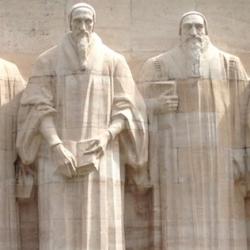During the early decades of the Reformation, there were efforts on all sides to reconcile Reformers and Catholics. Diarmaid MacCulloch (Europe’s House Divided) describes the ecumenical efforts of the Archbishop of Cologne, Hermann von Wied.
Von Wied was not a promising candidate to be a reform leader:
He was no great scholar, and his acquisition of the Archbishopric while still only a sub-deacon in 1515 did not suggest that he would break the mould of aristocratic German church leadership any more than his fellow-Elector in Mainz, Cardinal Albrecht. In fact, von Wied became an energetic reformer in his wealthy and powerful Rhineland prince-bishopric (which was another of the seven Electorates of the Empire). He called on the services of a distinguished theologian, Johann Gropper, to write ‘an Enchiridion to be a positive and constructive statement of the Church’s belief as well as a response to Melanchthon’s Loci. Gropper included a nuanced discussion of justification that much interested the Italian circle of Contarini and Pole. In 1536 the Archbishop summoned a provincial church synod to Cologne, and its reforming provisions were published in 1538 along with Gropper’s Enchiridion; they were in the tradition of humanist efforts to tidy the faults of the existing structures by recalling clergy to the strictest moral standards, and making sure that these clergy went on to give the laity proper and regular instruction in basic Christian doctrine. Copies circulated throughout Europe, and as far away as Scotland they were seen as the best programme available for a local church reform.
He went so far as to incorporate Protestants into his reforming efforts: “in 1539 von Wied invited Melanchthon and Martin Bucer to help him in preparing a more thoroughgoing scheme of reform for his diocese, and although Melanchthon eventually refused to compromise himself in this way, Bucer accepted. Similarly, in the same year, Bucer joined with Georg Witzel, a married priest whose early enthusiasm for Luther had cooled and who had returned to Roman obedience, in drafting a Church structure for Ducal Saxony in the wake of the death of Luther’s instransigent enemy Duke Georg.”
It was a remarkable sight: “an Archbishop of the Western Church who openly regretted the failure of repeated efforts to reform the Church, while still proclaiming his loyalty to the Holy See.”
These efforts came to a culmination in the 1541 Imperial Diet at Regensburg (Ratisbon). Henry VIII sent Bishop Stephen Gadiner of Winchester, Rome sent the irenic Cardinal Contarini. MacCulloch writes, “When introduced to Bucer, [Contarini] observed, ‘How great will be the fruit of unity, and how profound the gratitude of all mankind’. Bucer replied equally graciously: ‘Both sides have failed. Some of us have overemphasized unimportant points, and others have not adequately reformed obvious abuses. With God’s will we shall ultimately find the truth.’”
Not everyone wanted Regensburg to succeed: “some of the Emperor’s own princes were not anxious to see the Habsburg family’s problems solved, even less so the King of France, who would have been a necessary party to any final agreement.” But the politicians weren’t the cause of the failure; the theologians were: “Contarini could not give ground on the eucharistic doctrine of transubstantiation; the Protestants were not prepared to say that confession to a priest was necessary. Their measure of agreement on justification in the Regensburg Book was therefore irrelevant. Then messages from both Rome and Luther in Wittenberg made it quite clear that even that would not be accepted.”
The failure of the Diet had massive consequences in Italy: “Contarini had aroused many fears in Rome by his willingness to compromise and he died under house arrest, a broken man, in August 1542. By then, the more confrontational Spirituali [sympathetic to reform] were alert to the danger of their position. Valdés avoided the testing time by his death in 1541, but Bernardino Ochino was summoned to Rome when his sermons became ever more outspoken. Sensibly disregarding the order, he had time to say goodbye to the dying Contarini before he left on horseback for Switzerland and Calvin’s Geneva, and he was closely followed in his flight by Peter Martyr Vermigli, whose wanderings eventually took him to a warm welcome from Bucer in Strassburg. The sensation was huge at the flight of these preachers whom all Italy knew, and theirs were only the first in a series of defections of Italian scholars and theologians to the Reformed world across the Alps.”
From the Catholic viewpoint, some of the “brightest stars” had proven themselves traitors. The hardliners around Paul III urged the Pope to “set up a Roman Inquisition, modelled on the Spanish Inquisition, and with the Cardinal-Archbishop of Naples himself as one of the Inquisitors-General. The papal Bull was promulgated on 21 July 1542. ‘Even if my own father were a heretic, I would gather the wood to burn him,’ Carafa [the future Pope Paul IV] vowed.”
Efforts to reconcile Protestant with Protestant likewise came to various impasses. After Bullinger and Calvin unified non-Lutheran Protestants around the Consensus Tigurinus, Lutherans vigorously rejected the document: “plenty of ministers and theologians in Germany determined to champion his views, the chief among them being the principal pastor of Hamburg, Joachim Westphal. Westphal’s first pamphlet salvo against the Consensus in 1552 was full of personal abuse in German well down to the standards of Luther at his most truculent; Calvin became the ‘cow’ (das Kalb) and Bullinger inevitably the ‘bull’ (der Bulle).” Polemics became sharper, and the gulf between German and Swiss widened.
The figures who might have brought some calm were not available: “Bucer died far away in Cambridge in 1551. Melanchthon was actually offered the succession to Bucer’s academic job in Cambridge by the government of Edward VI of England, but he remained caught unhappily in Wittenberg because of King Edward’s sudden death in 1553; for years before his own death in 1560 he was himself the object of grave suspicion from self-appointed guardians of Luther’s legacy, who denounced aspects of his teaching, which they regarded as treacherous and labelled ‘Philippism.’”
As a result, “The division signalled so long ago at Marburg . . . hardened,” with sometimes dire practical consequences: “German and Scandinavian Lutherans behaved inhospitably in the 1550s to Protestant refugees from Roman Catholic persecution (for instance, people fleeing from Mary Tudor’s England to Lutheran Denmark) whom they regarded as belonging to the party of the Consensus.” By the mid-1550s, “the hopes of the early 1540s for a real reunion were dashed. It was not merely that Catholics and Protestants now turned from bringing together the house divided: Protestants too were increasingly accepting that their divisions were not going to be healed.”














